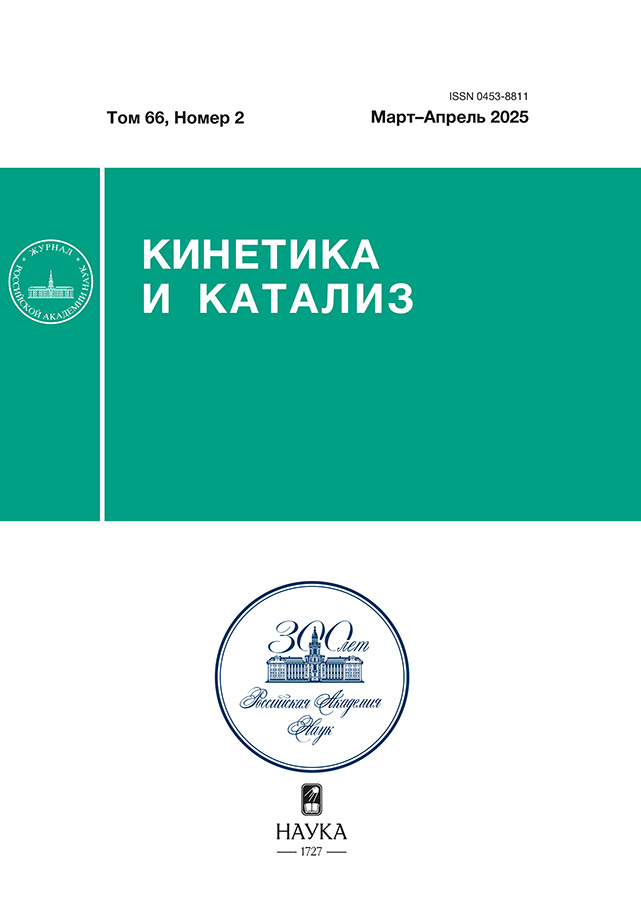The interaction of hydrazine monohydrate with the surface of metal-containing catalysts
- Autores: Matyshak V.A.1, Silchenkova O.N.1, Ilichev A.N.1, Bykhovsky M.Y.1, Morozova O.S.1
-
Afiliações:
- Semenov Federal Research Center for Chemical Physics RAS
- Edição: Volume 66, Nº 2 (2025)
- Páginas: 80-90
- Seção: ARTICLES
- URL: https://cardiosomatics.ru/0453-8811/article/view/689864
- DOI: https://doi.org/10.31857/S0453881125020029
- EDN: https://elibrary.ru/SKKVJJ
- ID: 689864
Citar
Texto integral
Resumo
The interaction of hydrazine monohydrate with nickel on various carriers has been investigated using a range of physical and chemical methods. Hydrazine monohydrate adsorbs on catalysts, both active and inactive, in the infrared region of the spectrum. The location of the particles of adsorbed hydrazine monohydrate is on the carrier. There was no correlation found between the spectral features on several of the catalysts studied and their catalytic activity in hydrogen formation. The main transformation reactions occur in the metallic phase of the supported catalysts. It was found that, due to the reaction energy, the size and structure of the clusters were reduced and rearranged to create centers suitable for the effective course of intramolecular dehydrogenation of hydrazine. At the same time, this process was most effective on smaller clusters, possibly because a stronger Me-H bond was formed on them. Adsorption of hydrazine monohydrate through hydrogen atoms was possible on these clusters. These conditions ensured the predominant formation of hydrogen at low temperatures. An increase in temperature contributed to the course of a competing reaction of ammonia formation, associated with the breaking of the N-N bond in the adsorption complex. As result, the formation of NH2 complexes is taking place, and then ammonia.
Palavras-chave
Texto integral
Sobre autores
V. Matyshak
Semenov Federal Research Center for Chemical Physics RAS
Email: son1108@yandex.ru
Rússia, Kosygina str., 4, Moscow, 119991
O. Silchenkova
Semenov Federal Research Center for Chemical Physics RAS
Autor responsável pela correspondência
Email: son1108@yandex.ru
Rússia, Kosygina str., 4, Moscow, 119991
A. Ilichev
Semenov Federal Research Center for Chemical Physics RAS
Email: son1108@yandex.ru
Rússia, Kosygina str., 4, Moscow, 119991
M. Bykhovsky
Semenov Federal Research Center for Chemical Physics RAS
Email: son1108@yandex.ru
Rússia, Kosygina str., 4, Moscow, 119991
O. Morozova
Semenov Federal Research Center for Chemical Physics RAS
Email: son1108@yandex.ru
Rússia, Kosygina str., 4, Moscow, 119991
Bibliografia
- Hydrogen and other Alternative Fuels for Air and Ground Transportation. Ed. Pohl H.W. UK: Wiley, 1995. 206 p.
- Wincewicz K.C., Cooper J.S. // J. Power Sources. 2005. V. 140. P. 280. https://doi.org/10.1016/j.jpowsour.2004.08.032
- Каленчук А.Н., Богдан В.И. // Кинетика и катализ. 2022. Т. 63. № 4. C. 516. https://doi.org/10.1134/s002315842204005x
- Al-Thubaiti K.S, Khan Z. // Int. J. Hydrogen Energy. 2020. V. 45. P. 13960. https://doi.org/10.1016/j.ijhydene.2020.03.093
- Motta D., Barlocco I., Bellomi S., Villa A., Dimitratos N. // Nanomaterials. 2021. V. 11. P. 1340. https://dx.doi.org/10.3390/nano11051340
- Adamou P., Bellomi S., Hafeez S., Harkou E., Al-Salem S.M., Villa A., Dimitraros N., Manos G., Constantinou A. // Catal. Today. 2023. V. 423. 114022. https://doi.org/10.1016/j.cattod.2023.01.029
- Adamou P., Bellomi S., Harkou E., Chen X., Delgado J.J., Dimitraros N., Manos G., Villa A., Constantinou A. // Chem. Eng. J. 2024. V. 493. 1527152024. https://doi.org/10.1016/j.cej.2024.152715
- Akbar Z.A., Situmorang S.V., Yati I., Yunarti R.T., Ridwan S.N. // Int. J. Hydrogen Energy. 2024. V. 57. P. 1506. https://doi.org/10.1016/j.ijhydene.2024.01.068
- Богданова Е.А., Пономарев И.Ю., Наседкин А.В. // Кинетика и катализ. 2022. Т. 63. № 3. C. 279. https://doi.org/10.31857/S0453881122030042
- Матышак В.А., Сильченкова О.Н. // Кинетика и катализ. 2022. Т. 63. № 4. C. 405. https://doi.org/10.1134/s0023158422040073
- Dai H., Zhong Y., Wang P. // Prog. Nat. Sci. Mater. 2017. V. 27. P. 121. https://doi.org/10.3390/catal10080930
- Du X., Liu C., Du C., Cai P., Cheng G., Lu W. // Nano Res. J. 2017. V. 10. № 8. P. 2856. https://doi.org/10.1007/s12274-017-1494-6
- Shi Q., Qiu Yu.-P., Dai H., Wang P. // J. Alloys Compd. 2019. V. 787. P. 1187. https://doi.org/10.1016/j.jallcom.2019.01.378
- Singh S.K., Iizuka Y., Xu Q. // Int. J. Hydrogen Energy. 2011. V. 36. № 18. P. 11794. https://doi.org/10.1016/j.ijhydene.2011.06.069
- Qiu Y.-P., Chen M.-H., Qin S.-H., Yang Z.-Q., Wang P. // Int. J. Hydrogen Energy. 2024. V. 50 (D). P. 3181. https://doi.org/10.1016/j.ijhydene.2023.09.244
- Качала В.В., Хемчян Л.Л., Кашин А.С., Орлов Н.В., Грачев А.А., Залесский С.С., Ананников В.П. // Успехи химии. 2013. Т. 82. С. 648. https://doi.org/10.1070/RC2013v082n07ABEH004413
- Matyshak V.A., Krylov O.V. // Catal. Today. 1995. V. 25. P. 1. https://doi.org/10.1016/0920-5861(95)00067-P
- Ramis G., Li Y., Busca G. // Catal. Today. 1996. V. 28. P. 373. https://doi.org/10.1016/S0920-5861(96)00050-8
- Amores J.M.G., Escribano V.S., Ramis G., Busca G. // Appl. Catal. B: Environ. 1997. V. 13. № 1. P. 45. https://doi.org/10.1016/S0926-3373(96)00092-6
- Chuang Ch.-Ch., Shiu J.-Sh., Lin J.-L. // Phys. Chem. Chem. Phys. 2000. V. 2. P. 2629. https://doi.org/10.1039/B001389G
- Матышак В.А., Сильченкова О.Н., Ильичев А.Н., Быховский М.Я., Mнацаканян Р.А. // Кинетика и катализ. 2023. Т. 64. № 6. C. 773. https://doi.org/10.31857/S0453881123060114
- Lieske H., Lietz G., Sprindler H., Volter J. // J. Catal. 1983. V. 81. P. 8. https://doi.org/10.1016/0021-9517(83)90142-2
- Alberas D.J., Kiss J., Liu Z.-M., White J.M. // Surf. Sci. 1992. V. 278. P. 51. https://doi.org/10.1016/0039-6028(92)90583-R
- Zhang P.-X., Wang Y.-G., Huang Y.-Q., Zhang T., Wu G.-S., Li J. // Catal. Today. 2011. V. 165. P. 80. https://doi.org/10.1016/j.cattod.2011.01.012
- Agusta M.K., David M., Nakanishi H., Kasai H. // Surf. Sci. 2010. V. 604. P. 245. https://doi.org/10.1016/j.susc.2009.11.012
- Bychkov V.Yu., Tyulenin Y.P., Korchak V.N., Aptekar E.L. // Appl. Catal. A: Gen. 2006. V. 304. P. 21. https://doi.org/10.1016/j.apcata.2006.02.023
- Bychkov V.Yu., Tyulenin Yu.P., Slinko M.M., Shashkin D.P., Korchak V.N. // J. Catal. 2009. V. 267. № 2. P. 181. https://doi.org/10.1016/j.jcat.2009.08.010
Arquivos suplementares

















